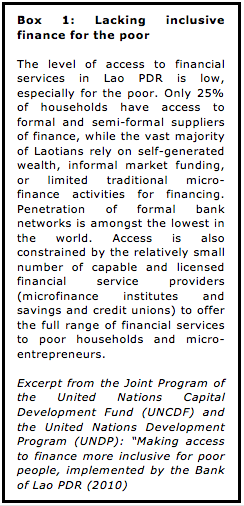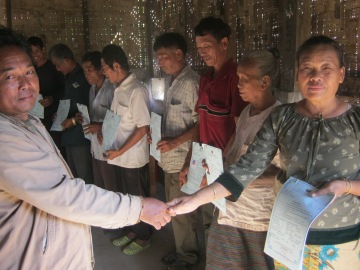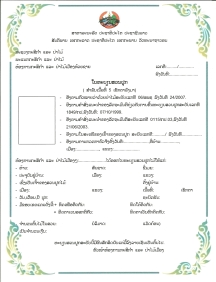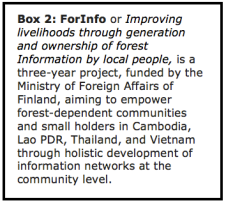Martin Greijmans, SPO Livelihoods & Markets.
February 28, 2013, Houay Xai, Bokeo, Lao PDR

Teak smallholders in Ban (village) Houaythongtai in Phaktha district, Bokeo province, Lao PDR, have been at the forefront in registering their teak lots since ForInfo initiated its regional project of innovation and information to support livelihoods.
 Communities in this typical northern Lao village heavily depend on rice for their own consumption, with some surplus being traded locally. When they are in need of cash, Lao farmers are forced to sell a few cattle (see box 1) or standing teak trees to local traders. Both these types of assets serve the families as a savings account, which they can fall back on to pay for hospital bills, children’s education or small household investments [see our previous blog entry on this topic: Money can Grow on Trees: Teak Assets in Northern Laos].
Communities in this typical northern Lao village heavily depend on rice for their own consumption, with some surplus being traded locally. When they are in need of cash, Lao farmers are forced to sell a few cattle (see box 1) or standing teak trees to local traders. Both these types of assets serve the families as a savings account, which they can fall back on to pay for hospital bills, children’s education or small household investments [see our previous blog entry on this topic: Money can Grow on Trees: Teak Assets in Northern Laos].
Teak logs to be sold to local sawmills and traders for sawn timber production should have a minimum diameter at breast height (DBH) of 12-15 cm. Better prices however are fetched at around 25 cm DBH as stated by the farmers. Teak smallholders who are in need of immediate cash are forced to sell trees even if these have not yet fully reached DBH classes with higher value, losing the full potential earnings from their trees. Additionally, traders who buy teak trees from smallholders select the best trees, cut and remove them, often without making immediate payments to the tree owners. Thus the smallholder who is already in need of cash remains in an uncertain position.

Teak smallholders receiving the certificate from forest officials.
ForInfo intends to support teak smallholders in delaying the sale of trees by providing them with an innovative collateral mechanism, which starts by mapping and documenting the available teak resources per smallholder, while also determining the current and future value of still developing tree stands [see our paper entitled “Local Processing of Logs to Increase Smallholder Share, Lao PDR,” on page 38 of ETFRN News 52]. Currently, 25 smallholder lots belonging to 21 households have been documented and certified by the provincial agriculture and forestry office, with another 14 applications in the process of approval. The remainder of interested teak rights holders [totaling 80] will also be served by ForInfo within the time span of the project.

Sample certificate given to teak smallholders, in Bokeo, Lao PDR.
However, even with the tree collateral model under development both smallholders and local government staff are of the opinion that by systematically documenting and mapping teak tree lots on smallholders’ land ForInfo has already achieved an important step towards empowering teak smallholders.
Interviews in Ban Houaythongtai with teak rights holders and district government staff reveal that the certificate issued by the provincial forestry office represents a clear right for the tree owners and is expected to enable them to make a case against traders which do not make fair and timely payments. This belief is backed by the local government, which requires solid documentation to fall back on, [the certificate representing the right holder’s formal registration of teak stands] and play the role of mediator effectively.
 What is happening now in Paktha is that property rights defined in the literature by Bromley (1991, p.15) as “the capacity to call upon the collective to stand behind one’s claim to a benefit stream” emphasizes the quality of the relationship between the right holder and the institution that backs the claim. The district and provincial forestry offices are keen to scale up this success to all teak villages in the district and when possible to the remainder of Bokeo province. Their willingness to invest time into this process is aligned with ForInfo’s main objective which is improving livelihoods (See Box 2).
What is happening now in Paktha is that property rights defined in the literature by Bromley (1991, p.15) as “the capacity to call upon the collective to stand behind one’s claim to a benefit stream” emphasizes the quality of the relationship between the right holder and the institution that backs the claim. The district and provincial forestry offices are keen to scale up this success to all teak villages in the district and when possible to the remainder of Bokeo province. Their willingness to invest time into this process is aligned with ForInfo’s main objective which is improving livelihoods (See Box 2).


Improving Rights and Benefits for Teak Smallholders
Martin Greijmans, SPO Livelihoods & Markets.
February 28, 2013, Houay Xai, Bokeo, Lao PDR
Teak smallholders in Ban (village) Houaythongtai in Phaktha district, Bokeo province, Lao PDR, have been at the forefront in registering their teak lots since ForInfo initiated its regional project of innovation and information to support livelihoods.
Teak logs to be sold to local sawmills and traders for sawn timber production should have a minimum diameter at breast height (DBH) of 12-15 cm. Better prices however are fetched at around 25 cm DBH as stated by the farmers. Teak smallholders who are in need of immediate cash are forced to sell trees even if these have not yet fully reached DBH classes with higher value, losing the full potential earnings from their trees. Additionally, traders who buy teak trees from smallholders select the best trees, cut and remove them, often without making immediate payments to the tree owners. Thus the smallholder who is already in need of cash remains in an uncertain position.
Teak smallholders receiving the certificate from forest officials.
ForInfo intends to support teak smallholders in delaying the sale of trees by providing them with an innovative collateral mechanism, which starts by mapping and documenting the available teak resources per smallholder, while also determining the current and future value of still developing tree stands [see our paper entitled “Local Processing of Logs to Increase Smallholder Share, Lao PDR,” on page 38 of ETFRN News 52]. Currently, 25 smallholder lots belonging to 21 households have been documented and certified by the provincial agriculture and forestry office, with another 14 applications in the process of approval. The remainder of interested teak rights holders [totaling 80] will also be served by ForInfo within the time span of the project.
Sample certificate given to teak smallholders, in Bokeo, Lao PDR.
However, even with the tree collateral model under development both smallholders and local government staff are of the opinion that by systematically documenting and mapping teak tree lots on smallholders’ land ForInfo has already achieved an important step towards empowering teak smallholders.
Interviews in Ban Houaythongtai with teak rights holders and district government staff reveal that the certificate issued by the provincial forestry office represents a clear right for the tree owners and is expected to enable them to make a case against traders which do not make fair and timely payments. This belief is backed by the local government, which requires solid documentation to fall back on, [the certificate representing the right holder’s formal registration of teak stands] and play the role of mediator effectively.
Share this:
Posted by RECOFTC on March 5, 2013
https://recoftc.wordpress.com/2013/03/05/improving-rights-and-benefits-for-teak-smallholders/